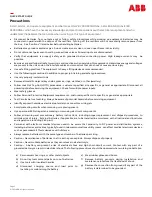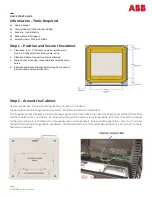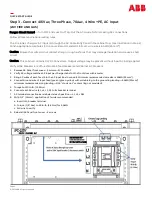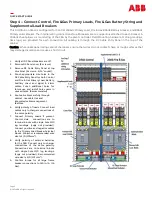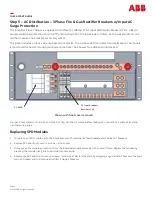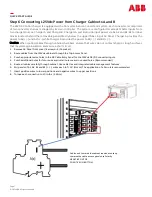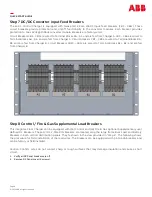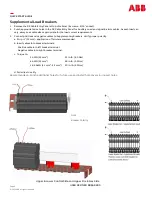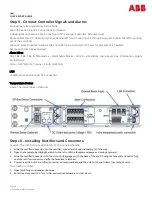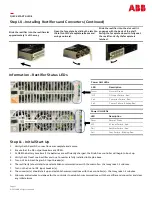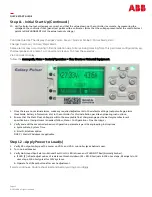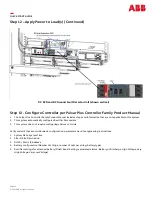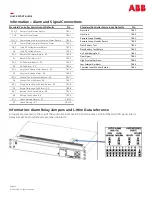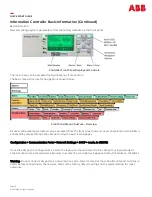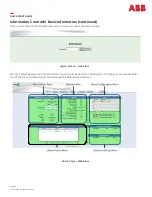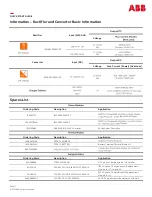
QUICK START GUIDE
Page 2
© 2021 ABB. All rights reserved.
Precautions
a)
Remove watches, rings, or other metal objects.
b)
Do not lay tools or metal parts on top of batteries.
c)
Use tools with insulated handles.
d)
Disconnect charging source and load prior to
installing or maintaining the battery.
e)
Wear rubber gloves and boots.
f)
Remove battery grounds during installation and
maintenance to reduce the likelihood of shock.
g)
Remove the connection from ground if any part of the
battery is determined to be grounded.
Install, service, and operate equipment and batteries ONLY BY PROFESSIONAL, SKILLED AND QUALIFIED
PERSONNEL who have the necessary knowledge and practical experience with electrical equipment and who
understand the hazards that can arise when working on this type of equipment.
•
Disconnect batteries from outputs and/or follow safety procedures while working on equipment. Batteries may be
connected in parallel with the output of the rectifiers. Turning off the rectifiers will not necessarily remove power from
the bus. See
“
Cautions
”
listed below before handling batteries.
•
Batteries may produce explosive gas. Do not create arcs, smoke, or use an open flame in the vicinity.
•
Do not disconnect permanent bonding connections unless all power inputs are disconnected.
•
Verify that equipment is properly safety earth grounded before connecting power. High leakage currents may be
possible.
•
Exercise care and follow all safety warnings and practices when servicing this equipment. Hazardous energy and voltages
are present in the unit and on the interface cables and connectors that can shock or cause serious injury.
•
Use safe lifting practices. The equipment is heavy. Lifting devices are recommended.
•
Use the following precautions in addition to proper job training and safety procedures:
•
Use only properly insulated tools.
•
Remove all metallic objects (key chains, glasses, rings, watches, or other jewellery).
•
Follow Lock Out Tag Out (LOTO) procedures: customer specified, site specific, or general as appropriate. Disconnect all
power input before servicing the equipment. Check for multiple power inputs.
•
Wear safety glasses.
•
Follow Personal Protective Equipment requirements: customer specified, site specific, or general as appropriate.
•
Test Circuits before touching. Always be aware of potential hazards before servicing equipment.
•
Identify exposed hazardous electrical potentials on connectors, wiring, etc.
•
Avoid contacting circuits when removing or replacing covers;
•
Use a personal ESD strap when accessing or removing electronic components.
•
Follow all warning and precautionary battery instructions, including proper replacement and disposal procedures, to
minimize risk of injury. External batteries, if applicable, are to be installed in accordance with all national and local rules
and regulations, including CEC, part 1.
•
Personnel with electronic medical devices need to be aware that proximity to DC power and distribution systems,
including batteries and cables, typically found in telecommunications utility rooms, can affect medical electronic devices,
such as pacemakers. Effects decrease with distance.
•
Always replace batteries with the same type and number of batteries per string.
•
Caution –
Never dispose of batteries in a fire as they can explode. Always dispose of properly.
•
Caution –
Never mutilate batteries as they can release toxic electrolyte.
•
Caution –
A battery can present a risk of electrical shock and high short
-
circuit current. Contact with any part of a
grounded battery can result in electrical shock. The following precautions should be observed when working on batteries:


